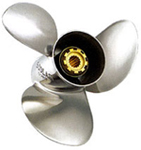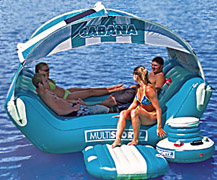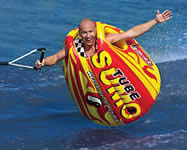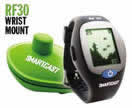

 |
 |
|
|
|
Tips on selecting the right boat propeller
When choosing a boat propeller, in order to achieve the best performance, you should first find out what your recommended wide open throttle (W.O.T.) R.P.M. operating range is for your engine. This will be in your engine owner's manual, if you don’t have a manual, call a local boat dealer who services your brand of engine and ask them what the W.O.T. range is. We might also know too, but not in all cases.
Usually in the W.O.T. range there ia a 400 to 1000 rpm difference between the lower number and the higher number. If you have the right propeller on your boat you should be in this range (preferably nearer the higher number) while going full speed and fully trimmed up if you have power trim.
Boats without tachometers are harder to prop right but if you can at least get the numbers of your old boat propeller that would help us greatly. (see bellow)
The next thing you should know is what size propeller you have on your boat right now and what your R.P.M.'s are doing with it at full speed and full trim.
Boat propellers come in different sizes. There will be some numbers stamped around the prop shaft hole (on the propeller) on the end where the prop nut goes on.
They also might be stamped in between the blades on the barrel part of the propeller.
These will be a part number and/or the actual size number. Either way we can determine what you have and go from there.
There are always two size numbers for any boat propeller.
The first number is the diameter (measured from the prop shaft hole out to one blade tip times two).
The second number is the pitch (how far a propeller should travel forward through a solid one revolution in terms of inches).
The pitch is the most important number because different pitches will make the engine R.P.M.'s change at full speed.
The theory is for every one inch in pitch the RPM's will change 150 to 200. The higher the number pitch means lower R.P.M.'s, and the lower the number pitch means higher RPM's.
So the quest is to get the right pitched prop that will get you in your recommended W.O.T. R.P.M. operating range.Aluminum propellers and Stainless Steel Propellers
Aluminum propellers are usually the standard prop that comes with the boat when it is new. They perform well enough for most people and are cheaper than stainless steel props.
Stainless steel propellers offer better performance (quicker time to plane off and faster top end speed) than the aluminums in most cases, especially for faster boats.
You have to be more careful though, since they don’t bend or break nearly as easily as an aluminum prop does, but for performance you can't beat them.Four and five blade boat propellers
These boat propellers are basically designed to get your boat up on plane quicker and for more powerful take offs. You probably will not go as fast as a three bladed prop will at full speed, but they work great for heavier boats and for pulling skiers, tubers, etc. They are a little more expensive than the three bladed boat props and they come in both aluminum and stainless steel.We hope this has been helpful to you and you might want to also check the resources page..
We offer too many boat propellers to list, please call us at 1-877-512-7767 (PROP) for a price quote, propeller recommendations and to place an order.




